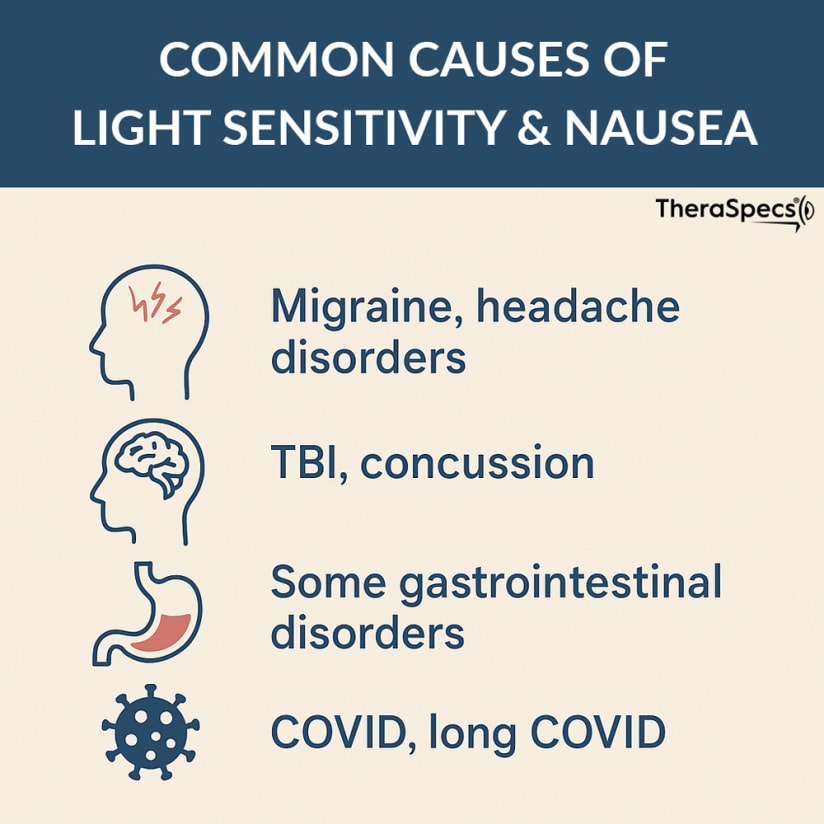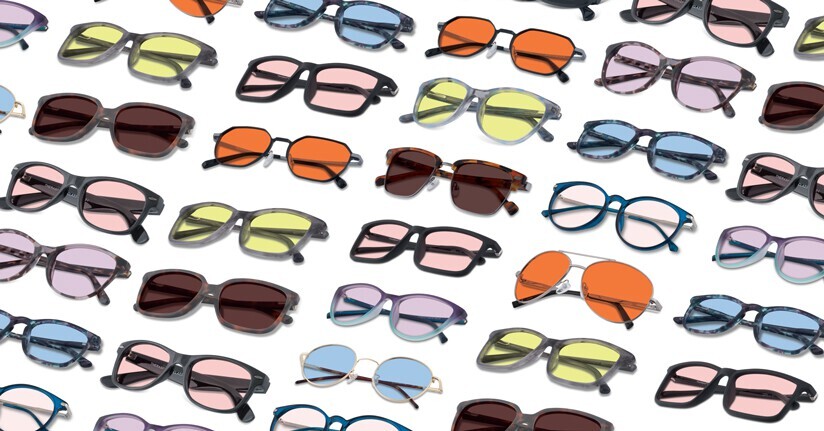Light Sensitivity with Nausea: Causes, Prevalence, and Impact
Key Highlights
- Light sensitivity can commonly occur together with nausea
- Conditions that cause both of these symptoms include migraine, brain injuries, gastrointenstinal disorders, and COVID/long COVID
- Lighting triggers like fluorescents and screens, along with non-lighting triggers like unpleasant smells, can aggravate nausea and photophobia
- Lighting adjustments at home and/or work, nausea-specific medications, and light sensitivity management glasses are among options for patients
For many, light sensitivity and photophobia does not just occur as an isolated symptom. It has been connected with other physical and sensory disturbances, such as dizziness, anxiety, and noise sensitivity (also known as phonophobia), among others. While you might not immediately associate them with one another, nausea can also co-occur with sensitivity to light. We explore how often it happens and the impact it can have on patients.
Causes of Light Sensitivity with Nausea
Many people who experience photophobia and nausea together have been diagnosed with an underlying condition that causes their symptoms. In particular, there are several notable disorders that can lead to the onset of these two issues simultaneously.

Migraine is often characterized by sensory disturbances to light, touch, sound and smell. Regardless of the specific migraine diagnosis, those who had nausea were more likely to also be sensitive to light.1 In fact, many clinical studies list photophobia and nausea as two of the three most bothersome symptoms. Researchers have further suggested that the specific sensory activation that leads to migraine-related nausea also creates a greater likelihood of photophobia.2 In addition, the intensity of head pain during an attack has been linked to both greater nausea and light sensitivity symptoms.3
Certain migraine types can make it more plausible that gastrointestinal (GI) symptoms will appear along with light sensitivity. Abdominal migraine typically impacts children, who develop symptoms like abdominal pain, nausea, and vomiting as well as sensory complaints such as photophobia during the attack phase. Another migraine type, vestibular migraine, is uniquely characterized by vertigo and dizziness; these issues accompany the “usual” migrainous symptoms like light and sound sensitivity and headache. In fact, nausea (80%) and photophobia (55%) were two of the top three symptoms of vestibular migraine.4 These problems often overlap during attacks and can appear at any stage of the migraine too.
Migraine is not the only condition that can result in light sensitivity with nausea. Cyclic vomiting syndrome similarly affects younger children and can make patients sensitive to light. One smaller study noted that approximately 17% with cyclic vomiting syndrome had this sensory sensitivity with their GI symptoms.5 Photosensitive epilepsy, in which seizures (and other symptoms) are triggered by flashing lights and other visual phenomenon, often feature migraine-like headaches and related sensitivities. Even people with cluster headache can experience these symptoms at staggering rates—perhaps as much as 75% for photophobia and 43% for nausea. In particular, women with cluster headache seem to have more nausea and vomiting with their cluster bouts, although light sensitivity likely affects men and women equally.6
These two symptoms are also hallmark effects of traumatic brain injury and concussion, especially with the impact that these injuries have on the vestibular system. Not only can they appear immediately after the TBI, but they can persist for weeks or months in some patients, including those with post-concussion syndrome. Experts have even identified post-traumatic migraine as a common headache type following a brain injury, which is explicitly characterized by head pain, light sensitivity, sound sensitivity and/or nausea. These complications can lead to longer recovery times, more total symptoms, and worsening outcomes for patients.7-8
If the primary condition is gastrointestinal in nature, you can also experience these two symptoms. Irritable bowel syndrome (IBS) has been linked to dry eye disease, which is one of the leading causes of light sensitivity, and it has been further connected to greater photophobia if you have both IBS and migraine.9,10 Functional gastrointestinal disorders are the result of gut-brain problems, and they too can leave afflicted persons with recurring nausea and a higher risk of photophobia.
Finally, COVID-19 infection and/or Long COVID have become emerging causes of persistent headaches with co-occurring nausea and sensitivity to light. Over 40% of people with COVID-19 caused headaches have reported each of these physiological complaints, and some had their symptoms last 30-60 days, if not longer.11
Even with all of these disorders, this list is not inclusive of everything. It is highly likely that several other conditions can result in the onset of these symptoms too.
Triggers of Light Sensitivity and Nausea
While photophobia and nausea are symptoms that people experience, light exposure can trigger both of them as well. The brightness levels, specific wavelengths of blue light, and the invisible pulsing in certain sources all contribute to the onset of these problems—particularly for migraine, other headache disorders and TBI. This is why fluorescent and LED lights, computer and smartphone screens, and sunlight consistently make the list of top triggers for light-sensitive persons. Even for healthy individuals, short-wavelength blue light led to motion sickness and more severe nausea, especially with repeated exposure.12
Read more about common triggers of light sensitivity
Nausea-related factors can also act as a trigger for both symptoms. For example, osmophobia, or sensitivity to smell, is associated with migraine and has the capability to instigate an attack that features nausea and other GI symptoms along with light sensitivity. Abnormal taste sensitivities can also affect individuals with migraine; as you might imagine, one unpleasant or unexpected flavor can be enough to bring on an attack.
Of course, there are a variety of triggers (beyond light and smell/taste) that can initiate symptoms of the conditions we have discussed. Any exposure to them can activate the brain and body in ways that turn into light-sensitive episodes with feelings of nausea.

Impact of Co-Occurring Photophobia with Nausea
As you might imagine, light sensitivity and nausea are debilitating on their own. Light sensitivity can feel painful and disorienting while also making us more anxious and fearful to be around potential light triggers. Nausea can turn our insides into a roller coaster and often exists with other symptoms like vomiting, constipation, and/or stomach pain. So when you put them together, it can significantly compound the problem.
We also have seen that the burden of these two symptoms together makes patients worse off. Specifically, people who were diagnosed with migraine AND had symptoms of light, sound and smell sensitivity had worsening headache-related disability.13 This can lead to negative effects throughout one’s life, from professional outcomes to personal relationships. Anxiety and emotional or cognitive issues can complicate matters and hasten the development of photophobia and nausea.14
How to Alleviate Light Sensitivity and Nausea
Given the heavy burden of multiple sensory and physical symptoms, addressing photophobia and nausea becomes a critical step in the journey. Even if relief can be found for only one of them, it can make a significant difference in quality of life.
We always recommend consulting with your doctor and/or specialist to determine the most appropriate course of action for all of your symptoms. There are a variety of therapies for improving nausea symptoms, whether they are general remedies or designed for specific causes like migraine.
There are several options for relieving sensitivity to light too. For example, you can make adjustments in the lighting of your home and/or work environment, enact behavioral changes such as regular eye breaks from triggering sources, and wear tinted eyewear designed for light sensitivity.
TheraSpecs, in particular, features a variety of glasses that filter the most problematic blue wavelengths to which light-sensitive individuals are hyperreactive; this includes FL-Pro and FL-Blend for indoor use and FL-Sun if you want a polarized option for outdoors. In a comparison with other tinted glasses, TheraSpecs wearers were 3X more likely to report improved light sensitivity management. Here is what a few of them had to say about their experience:
"My indoor [FL-Pro] and outdoor [FL-Sun] TheraSpecs have alleviated my post-concussion syndrome symptoms of light sensitivity, migraine headache, nausea, and dizziness without meds! I can function again." - Betty, Pennsylvania
"It helped manage my difficulty of photophobia 10 years after Lasik surgery. Fluorescent lighting which highly irritated me with dizziness and nausea, no longer happens." - David, North Carolina
"My TheraSpecs have made such a difference in my life. Before wearing them I had a lot of trouble with fluorescent lights, causing head pain, some nausea, and just an overall 'off' feeling. I would cringe and be filled with dread when I knew I had to go into a big box store. Now that I have my TheraSpecs for indoors, I am able to go into these stores without all the issues I had before. They just make everything look happier." – Ashley, Indiana
As always, you should also take the medications for your condition as prescribed to help reduce the collection of symptoms that come along with it. General strategies for trigger management are also effective in reducing the load on your brain and body while also potentially preventing light sensitivity and nausea.
More Reading: Light Sensitivity + Other Symptoms
Photophobia and Phonophobia: Are Light and Sound Sensitivity Linked?
Does Light Make You Tired? Fatigue and Light Sensitivity
Can Light Sensitivity Lead to Blurry Vision?
Light Sensitivity and Dizziness
References:
1Min YW, Lee JH, Min B-H, et al. Clinical predictors for migraine in patients presenting with nausea and/or vomiting. Journal of Neurogastroenterology and Motility. 2013;19(4):516-520. doi:10.5056/jnm.2013.19.4.516.
2Drummond PD. Motion sickness and migraine: optokinetic stimulation increases scalp tenderness, pain sensitivity in the fingers and photophobia. Cephalalgia. 2002;22(2):117-124. doi:10.1046/j.1468-2982.2002.00332.x
3Kelman L, Tanis D. The relationship between migraine pain and other associated symptoms. Cephalalgia. 2006;26(5):548-553. doi:10.1111/j.1468-2982.2006.01075.x
4Teggi R, Colombo B, Albera R, et al. Clinical features of headache in patients with diagnosis of definite vestibular migraine: The VM-phenotypes projects. Frontiers in Neurology. 2018;9. doi:10.3389/fneur.2018.00395.
5Ertekin V, Selimoğlu MA, Altnkaynak S. Prevalence of cyclic vomiting syndrome in a sample of Turkish school children in an urban area. J Clin Gastroenterol. 2006;40(10):896-898. doi:10.1097/01.mcg.0000212627.83746.0b
6Rozen TD, Niknam RM, Shechter AL, et al. Cluster headache in women: clinical characteristics and comparison with cluster headache in men. Journal of Neurology, Neurosurgery & Psychiatry 2001;70:613-617.
7Womble MN, McAllister-Deitrick J, Marchetti GF, et al. Risk Factors for Vestibular and Oculomotor Outcomes After Sport-Related Concussion. Clin J Sport Med. 2021;31(4):e193-e199. doi:10.1097/JSM.0000000000000761
8Kontos AP, Reches A, Elbin RJ, et al. Preliminary evidence of reduced brain network activation in patients with post-traumatic migraine following concussion. Brain Imaging Behav. 2016;10(2):594-603. doi:10.1007/s11682-015-9412-6
9Asproudis I, Tsoumani AT, Katsanos KH, et al. Irritable bowel syndrome might be associated with dry eye disease. Ann Gastroenterol. 2016;29(4):487-491. doi:10.20524/aog.2016.0064
10Uluduz D, Cakmak S, et al. A Link between Migraine, Tension Type Headache and Irritable Bowel Syndrome: Clinical and Genetic Indicators (P4.120). Neurology. 2016;86(16 Suppl):P4.120. doi:10.1212/WNL.86.16_supplement.P4.120.
11Sampaio Rocha-Filho PA, Albuquerque PM, Carvalho LC, Dandara Pereira Gama M, Magalhães JE. Headache, anosmia, ageusia and other neurological symptoms in COVID-19: A cross-sectional study. The Journal of Headache and Pain. 2022;23(1). doi:10.1186/s10194-021-01367-8.
12Kim K, Hirayama K, Yoshida K, et al. Effect of exposure to short-wavelength light on susceptibility to motion sickness. Neuroreport. 2017;28(10):584-589. doi:10.1097/WNR.0000000000000802
13Suzuki K, Suzuki S, Shiina T, et al. Investigating the relationships between the burden of multiple sensory hypersensitivity symptoms and headache-related disability in patents with Migraine. The Journal of Headache and Pain. 2021;22(1). doi:10.1186/s10194-021-01294-8.
14Iverson GL, Greenberg J, Cook NE. Anxiety Is Associated With Diverse Physical and Cognitive Symptoms in Youth Presenting to a Multidisciplinary Concussion Clinic. Front Neurol. 2022;12:811462. Published 2022 Feb 7. doi:10.3389/fneur.2021.811462
Last updated 3rd Nov 2025

TheraSpecs® Glasses for Light Sensitivity
Find the glasses that fit your needs and lifestyle, and stay protected from screens, fluorescents, unwanted blue light, sunlight, flashing lights, and more.
Shop Now





